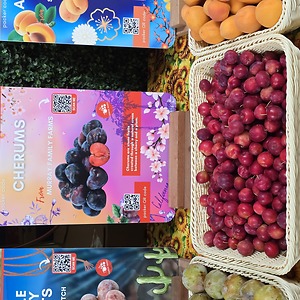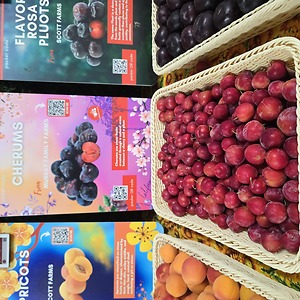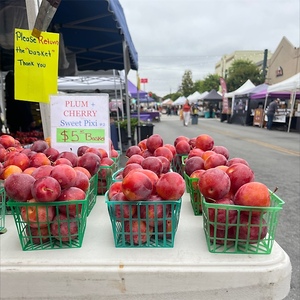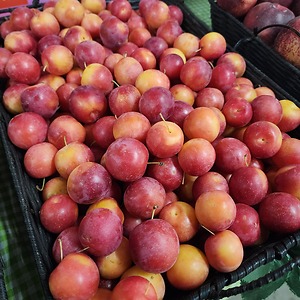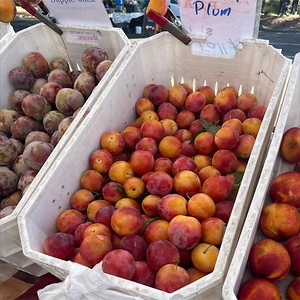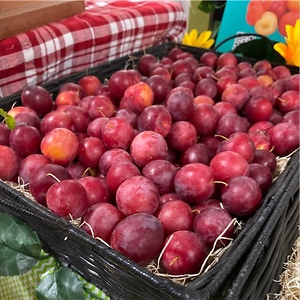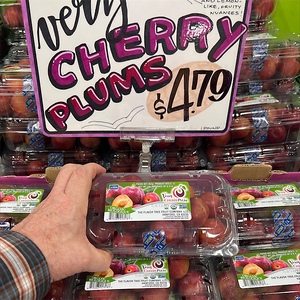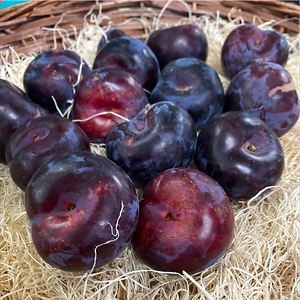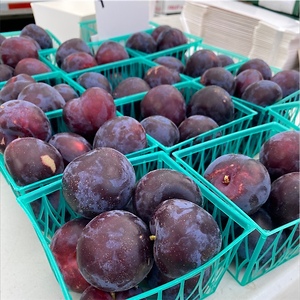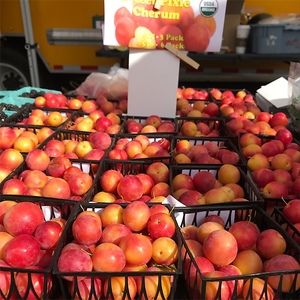


Cherums Pixie
Estimated Inventory, lb : 0
This item was last sold on : 07/09/25
Description/Taste
Cherums are small hybrid stone fruits, averaging about 2 to 3 centimeters in diameter, with a rounded, slightly heart-shaped appearance. Their skin feels firm yet thin, making the fruit easy to bite into. Cherums have a shiny and smooth surface that’s occasionally coated with a light chalky residue. Their skin is a dark reddish-purple hue, lighter in some spots than others, and speckled with pale lenticels. This variety has a semi-translucent flesh that's succulent yet firm, easily releasing juice when squeezed. They have a bright red hue that fades towards the center, where small yellow veins extend outward. In this center, a hard, light brown stone sits at the top rather than the exact core of the fruit. This small hard stone is inedible and should be removed before eating. Cherums' slightly tart skin compliments the distinctly sweet, juicy taste of their flesh, echoing the flavors of a plum.
Seasons/Availability
Cherums are available in the late summer.
Current Facts
The botanical name for Cherums is Prunus cerasifera and they belong to the Rosaceae family, which also includes apricots, nectarines, peaches, and almonds. They are a natural cross between cherries and plums and are often referred to as Pliers, Chums, Cherry plums, and Myrobalan plums. Cherries and plums were first bred in the late 1800s when a Sandcherry tree was crossed with a Japanese plum tree. The first attempt created a fruit that could be used for preserves but was not sweet enough to eat on its own. Breeders continued to experiment with other varieties like Black Amber Asian plums and Supreme cherries, which have proved more successful in bearing fresh-eating fruits. Cherums should not be confused with plerries, as Cherums possess the genes and characteristics of cherries, whereas plerries are more reflective of plums. Cherums are used for both their culinary and ornamental qualities, as their trees grow pale pink flowers resembling Japanese cherry blossoms. There are many commercial varieties of this hybrid, including Pixie Sweet® and Verry Cherry Plums®.
Nutritional Value
Cherums are a good source of vitamins B and C, nutrients essential for brain function, digestion, skin health, muscle tone, immunity, collagen production, and iron absorption. They contain calcium and phosphate that encourage strong bones and teeth, nerve signaling, blood clotting, and energy production. This fruit also provides potassium and iron to help maintain fluid balance, blood pressure, oxygen transportation, and cognitive function. Potassium may also reduce the risk of kidney stones and bone loss. The flowers that bloom from Cherum trees were once used by Dr. Edward Bach as a remedy to promote self-control.
Applications
The sweet taste of Cherums bodes well for fresh eating, cooking, pickling, and preserving. The fruits’ small size and thin skin makes them easy to consume without slicing or peeling. Cherums should be washed and deseeded before eating as the stone contains a toxin called amygdalin. In their fresh state, these hybrids can be enjoyed with green or fruit salads, charcuterie boards, smoothies, acai bowls, and salsas. When cooked, Cherums can be served on top of sweet foods like waffles, pancakes, oatmeal, ice cream, and cakes or mixed with savory grilled seafood dishes and stir-fries. They can be incorporated into baked goods like tarts, pies, puff pastries, and muffins or preserved in syrup, jam, compote, or sweet fruit sauces. This varietal may be utilized to make tkemali, a cherry plum sauce from the Republic of Georgia. Underripe Cherums can be used to sour soups, a culinary practice common in Romania, while the overripe fruit may be fermented to make moonshine. They pair well with grilled meats, red onions, cilantro, limes, apricots, strawberries, bananas, spinach, shrimp, chicken, pork, basil, mint, and balsamic vinegar. Cherums may be stored in the refrigerator for up to three weeks.
Ethnic/Cultural Info
Cherums were developed by Zaiger Genetics, a fruit breeder known for their hybrid creations. This California-based company has produced approximately 50 different cherry plum hybrids, focusing on commercially viable varieties that are higher in sugar, less prone to cracking, and have later maturity dates. Zaiger has also bred apricots and plums to create pluots and apriums, which are hybrids with varying levels of genetic inheritance from each parent. Though the goal of interspecies crossing is often to achieve a larger fruit, this wasn’t the case with Cherums. Zaiger’s goal was to develop a cherry-sized fruit that took from the desirable traits of plums.
Geography/History
The first Cherums were developed by Zaiger's Genetics of Modesto, California. They were a result of the continuous crossbreeding of cherries and plums that started in the late 1800s. This variety has become increasingly popular as interest in hybrid stone fruits has grown. Throughout the late 2000s, many different varieties of Cherums were developed, including the Pixie Sweet® in 2012. These fruits grow best in temperate climates with warm summers and cold winters. A cultivated variety not sown in the wild, Cherums can be hard to find as they are only grown by a few select orchards and are available for a limited time during the summer. They are most likely spotted at farmer’s markets or regional grocery stores in California.
Featured Restaurants
Restaurants currently purchasing this product as an ingredient for their menu.
| Finca North Park | San Diego CA | 619-581-3003 |
| Wildland | Carlsbad CA | 619-385-0914 |
| Knotty Barrel- Rancho | San Diego CA | 858-484-8758 |
| Panama 66 | San Diego CA | 619-206-6352 |
| Marriott Marina Kitchen | San Diego CA | 619-234-1500 |
| Joya Kitchen | San Diego CA | 619-255-5979 |
| Royal Polaris Sportfishing | San Diego CA | 619-226-8030 |
| The Kitchen at MCASD | La Jolla CA | 619-880-8719 |
| C 2 C | San Diego CA | 619-972-9345 |
| Wolf In the Woods | San Diego CA | 619-851-7275 |
| Kettner Exchange | San Diego CA | 909-915-9877 |
| Park Commons - ARE | San Diego CA | 619-295-3172 |
| Golden Door | San Marcos CA | 760-761-4142 |
| Park Hyatt Aviara | Carlsbad CA | 760-448-1234 |
| The Seabird Resort | Oceanside CA | 442-222-9505 |
| Sago | Encinitas CA | 858-382-4047 |
| Fairmont Grand Del Mar | San Diego CA | 858-314-1975 |
| Noble House Hotels & Resorts | San Diego CA | 619-276-4010 |
| Paradisaea Restaurant | La Jolla CA | 732-915-6669 |
Recipe Ideas
Recipes that include Cherums Pixie. One
| Feast Magazine |
|
Berkshire Pork Chops with Stone Fruit Chutney |



